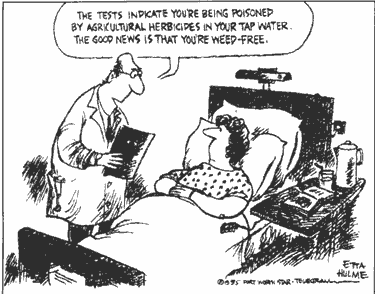Bangladeshis Sipping Arsenic as Plan for Safe Water Stalls
By BARRY BEARAK
CHOTOBINAR CHAP, Bangladesh — The arsenic, a slow, sadistic killer, has just about finished its work on Fazila Khatun. She teeters now. The fatigue is constant. Pain pulses through her limbs. Warts and sores cover the palms of her hands and the soles of her feet, telltale of the long years of creeping poison.
Mrs. Khatun is hardly alone in this suffering. Bangladesh is in the midst of what the World Health Organization calls the “largest mass poisoning of a population in history.” Tens of thousands of Bangladeshis show the outward signs of the same decline. Some 35 million are drinking arsenic-contaminated water, the poison accumulating within them day by day, sip by sip.
This calamity is accompanied by paradox. For two decades, the government, along with Unicef and various aid groups, desperately worked to wean the nation from pond water, often an incubator for lethal disease. People were instead urged to install tube wells, tapping into the plentiful supply of underground aquifers. Regrettably, no one had tested these subterranean sources for arsenic.
By the mid-1990’s, Bangladeshi officials — once reluctant to provoke alarm — finally admitted that yet another tragedy was unfolding in their impoverished, disaster-plagued nation. In 1998, the World Bank sped the normal paperwork and lent the government $32.4 million to act on the emergency. Every tube well was to be tested. Safe sources of water were to be provided.
But the race against time has gone badly. In the four years since The New York Times first looked into the situation, the nation’s “arsenic mitigation project” has been hobbled by the unforeseen problems of so unprecedented a crisis. It is yet another example of how the world’s poor continue to die from unsafe water, a threat long ago surmounted by the wealthy.
Suspicious of each other, the World Bank and the government became stubbornly bound up in their mutual bureaucracies, many critics say. Most of the country’s estimated 11 million wells have yet to be tested. Most stricken villages are absent solutions. Most people — the trusting converts to the “safety” of tube wells — are baffled when now told that within the water lie the malign beginnings of arsenic-induced cancer.
“It seems like nonsense to people, telling them the water is killing them when it looks so clean and nice,” said Dr. Allan H. Smith, an epidemiologist at the University of California at Berkeley and an expert on arsenic.
Dr. Smith has called the situation in Bangladesh “the highest environmental cancer risk ever found,” worse than Bhopal or Chernobyl.
“People need to stop drinking the contaminated water,” he said. “But they don’t seem to pay attention unless there are people around them showing signs of the disease, which is of course what we’re trying to prevent.”
Here in the village of Chotobinar Chap, with the cancer pulling her under, Mrs. Khatun seems to have surrendered. She has no strength for work. She has no appetite for meals. She lies in a spare room beneath a thatched roof.
“I feel myself fading away, and sometimes I ask God to take me,” she muttered. “My husband has abandoned me. He doesn’t even look at me anymore.”
For nearly two decades, Mrs. Khatun, 39, pumped the iron handle of a tube well sunk in her front yard beside a palm tree. Her father-in-law, Abdul Hakim, his six sons and all their families used the same convenient apparatus.
Two years ago, the water was tested. The arsenic concentration measured .760 milligrams per liter, 15 times the amount considered safe by Bangladesh standards and 76 times the limit set by the World Health Organization.
Arsenic, a speedy killer in high doses, is a sluggish and fickle assailant in low ones. The poison requires 2 to 10 years or more to work its damage and it affects different people in different ways — and some, seemingly, not at all.
While Mrs. Khatun is the most woefully stricken in her family, others have the same nodules on their palms and heels and dark spots on much of their skin. Still others, their thirst slaked from the same well, show no signs at all.
Informed of the danger, the family beseeched, “Where can we get safe water?” Here again the arsenic displayed its erratic hand, for some of the wells here are terribly tainted and others, just yards away, are harmless.
The nearest safe water for the family was beside a neighbor’s home a quarter mile away. To get there required a walk on a narrow mud path, past several houses with shiny tin roofs, past ponds where animals bathed and algae bloomed.
“It was hard to fetch water from so far away,” said Mr. Hakim, a weaver. Dark spots pocked his bare chest. “One of my daughters-in-law would go and carry back a full pitcher for drinking. But sometimes the path was too muddy. It was knee deep. She couldn’t wade through it and she stopped going.”
It is difficult to predict how many Bangladeshis will eventually die from causes related to the arsenic. Most researchers, including Dr. Smith, are shy with estimates. Richard Wilson, a Harvard physicist who is an expert in risk analysis, puts the number at one million. Dr. Sk. Ahktar Ahmad, a public health specialist with the government, predicts a total of three million to five million.
Any such arithmetic is highly speculative. The morbid work of the arsenic — a persistent nudging toward cancers of the liver, lung, bladder or kidney — can be halted in most cases by simply switching to safe water, doctors say.
So the question is: How many Bangladeshis will be persuaded to switch? And, if persuaded, how many can find water both safe and accessible?
Alternatives do exist. There are even ways to filter arsenic from water. But each solution requires effort, to educate villagers and to pay for the required equipment.
With 130 million people, Bangladesh is the world’s eighth most populous nation, its citizens packed into a territory slightly smaller than Wisconsin. The average per capita income is $370.
Bangladeshis Sipping Arsenic as Plan for Safe Water Stalls
Arsenic has competition on the nation’s mortality tables. Each year, pneumonia kills 91,000 children under age 5. Diarrhea claims 61,000 more. Tobacco surely rivals arsenic as a progenitor of fatal cancer.
Mother Nature, prone to furious mood swings, is often a mass murderer. In the wet summers, melting snow from the Himalayas joins with monsoon rains to overwhelm the rivers, flooding as much as two-thirds of the landscape. In dry months, the fierce sun can parch the soil enough to trigger a famine.
A few miles from here is Khandkar Kalagachia. As in most hamlets, there is water, water everywhere: wells, ponds, irrigated fields.
Though many of the villagers display signs of the poisoning, it is hard to know the extent of the contamination. Khandkar Kalagachia lies on the wrong side of the road, among the 77 percent of the nation’s “hot spot” areas still untested.
Muhammad Ahsanullah, a rickshaw puller, endures an overwhelming itchiness, another of the symptoms. His hands are always in motion, scratching their way from his palms to his wrists to his biceps to his shoulders. In one dexterous maneuver, he crosses his arms to get at his sides, looking like a man confined to a straitjacket.
“I should drink from another well,” Mr. Ahsanullah, 45, said.
His fingers have lesions the size of chickpeas. His soles are similarly affected, a hazardous problem for a rickshaw puller who goes barefoot. Infected wounds often lead to gangrene.
As Mr. Ahsanullah spoke, a small crowd gathered. Some of the men pulled up shirts to show their own dark speckling or lumpy palms.
Standing at the front door of a shack was a young woman, Khorsheda Begum, the rickshaw puller’s wife. The couple wed three years ago. Their families had arranged the marriage. She had never seen him until the wedding day.
Now, sheepishly, she admitted she wished she could undo their union. A village quack has told her — incorrectly — that her husband’s skin condition is contagious. Actually, the grave danger comes from the tube well in the yard.
“Yes, I drink from it,” she said. “We all do.”
Their well is the standard device, a small cylinder sunk into the earth with a hand pump above ground. Its location was familiar to Mostafa Kamal, an engineer who works for an aid agency called Proshika. He had once tested the well and found it contaminated. But for one reason or another, he had never gotten back to Khandkar Kalagachia to assay any other samples.
“Please test our wells now,” one man pleaded.
But the engineer could not comply. He was apologetic. His agency had a contract to examine wells. “But I only have supplies to test 200 a month and I have run out,” he said. “I can request more but I don’t think I will get it.”
From the start, the effort to correct the problem has run into problems. The primary mission was the testing of every well. If the water was safe, the top of the well was to be painted green. If not, it would be colored red.
This task required test kits that could accurately measure minuscule levels of arsenic, but nothing that precise was immediately available. While it was presumed that every family had a right to know if their well was tainted, little had been decided about how to help the unlucky.
“We started taking the measurements, but as we tested, painting the wells red or green, there was a great hue and cry from people with contaminated water,” said a government official. “These people asked us, What do you expect us to do now?”
“It took us a while to come up with new technologies, such as pond sand filters or rainwater harvesting or, in some areas, deeper tube wells,” the official said. “Different areas have different solutions. But once the best one is decided, to whom do you provide the money for installation? How do you prevent corruption?”
Programs were required, and each scheme seemed to call for round after round of design. The World Bank, after lending so much money, wanted the protection of exacting oversight. Some government officials, practiced in steering contracts to cronies, had supervisory interests of their own.
“It has been terrible frustration to watch,” said Han A. Heijnen, the environmental health adviser for the World Health Organization in Dhaka, the capital of Bangladesh. “So much remains to be done. Even now, the lack of knowledge among villagers about arsenic is a shame.”
The arsenic itself may well have been in the area’s alluvial sediments for 20,000 years or more. Exactly how it came to dissolve in the groundwater is a matter of debate, but the prevailing theory is that it was a natural process.
Whatever the cause, the arsenic’s belated discovery is at the root of the calamity. Water-quality experts are divided about how much, if any, negligence was involved. Some victims are suing the British Geological Survey, which did not include a test for arsenic when it surveyed the groundwater in 1992.
But even after the poison was found, responses were tardy. Unicef is now a dedicated participant in the testing of wells, but it and the government were slow to admit that their “safe water program,” the laudable effort to stop people from drinking from disease-laden ponds, had dire unintended consequences.
Now, with the disaster continuing, Bangladesh is of great interest to global experts, their laboratory for the study of arsenic.
Researchers have questions, among them: Has the poison breached the food chain? Why are some people more affected than others? Is the level of arsenic in each tube well stable? Will fatalistic villagers change their habits?
Mr. Ahsanullah, the rickshaw puller, incessantly scratching, had himself given thought to an alternate source of water. Recently, he began using a neighbor’s well.
“But now I am told that, too, is bad,” he said as he stood amid lush greenery and sprawling ponds. Within 20 feet, villagers were sloshing through the shallows that nourished a rice paddy. Still, the confused man, displaying his fear, asked gravely, “Where can I find water?”
(more…)







